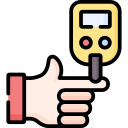Please note reduction in treatment WILL be required when steroid dose is reduced or stopped with a particular emphasis on the avoidance of hypoglycaemia. As a guide a 20% reduction in the insulin dose or 40mg reduction in gliclazide weekly as steroids are weaned is reasonable. Contact the diabetes team if there are concerns.
If CBG >12mmol/L (or individulalised target) start 40-80mg gliclazide in AM, or titrate morning dose if already taking gliclazide
If CBG >20mmol/L CONTACT DIABETES TEAM- MAY NEED INSULIN

Titrate gliclazide daily in increments of 40-80mg until CBG in target or on maximum of 240mg in AM
(CAUTION if eGFR <30, CONTACT DIABETES TEAM if eGFR <15)

If CBG still >12mmol/L, add in insulatard 10 units in AM and call diabetes team in hours

